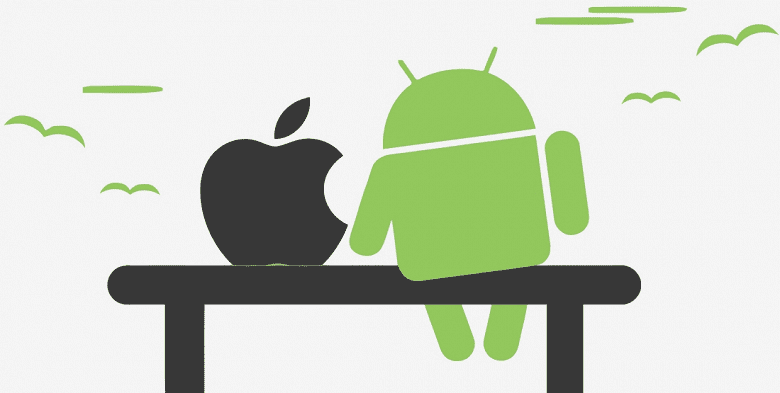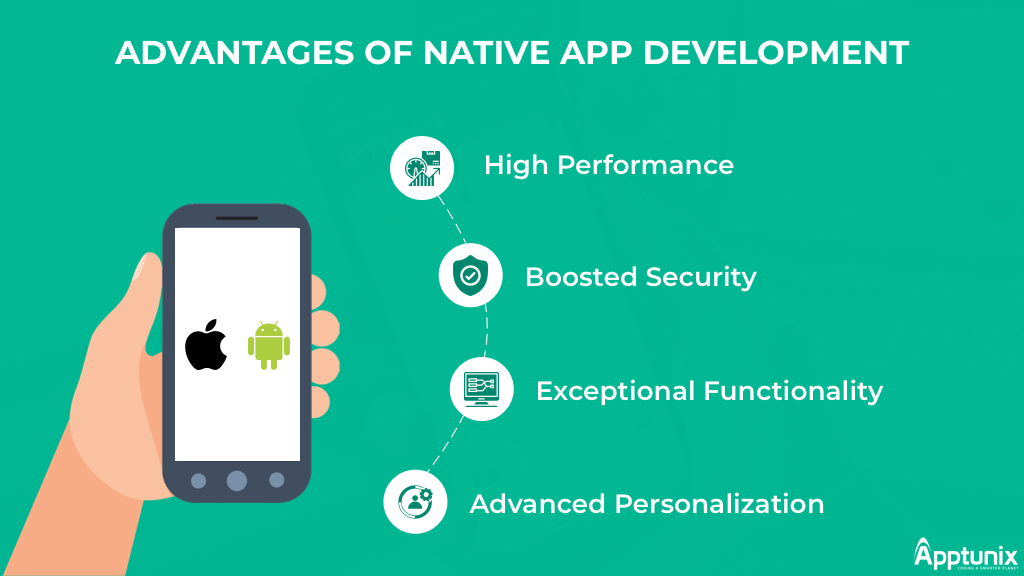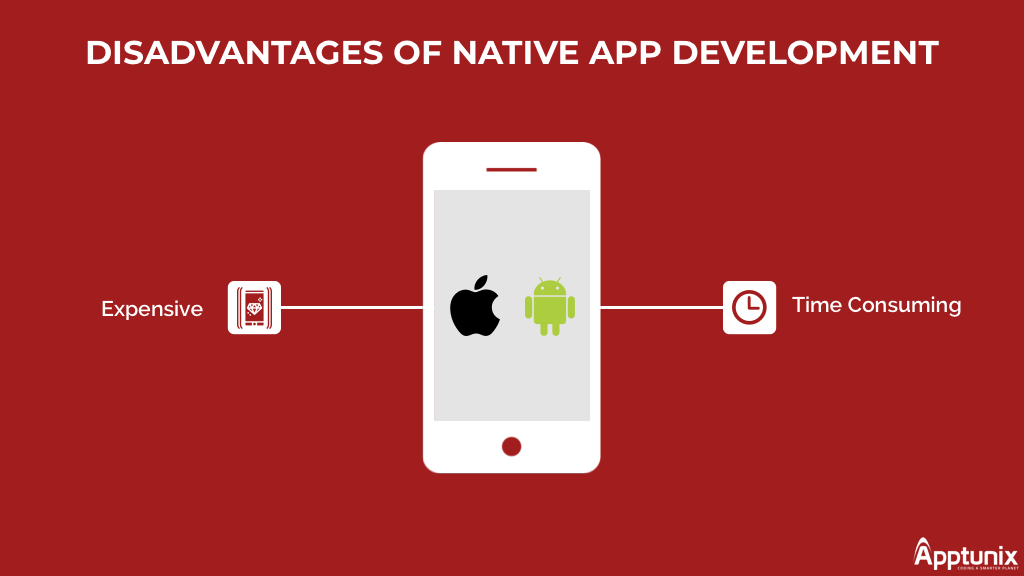< BLOG
Native Mobile App Development: How to Make Two Apps for iOS & Android and Make Sure That They Will Work Amazingly?
03 JUN 2022
Without further ado, mobile apps are very cool. And being the owner of one, too. If you want your project to exist online — it’s worth investing money in building your mobile app. But users will not choose your application if it is not well developed. There are two ways to develop a mobile app — cross-platform or native. Spoiler alert: if you want your app to be feature-rich, pull nice animations, and crash less — choose native mobile app development. We could end here, but you probably want to know more: what’s so good about native development? I’m a mobile development expert at Brivian, and I’ll tell you everything!
 There are two main operating systems for mobile apps in the world — iOS and Android. Both systems are super different, and they require different development languages. Therefore, to develop a mobile app for two different systems, you need to hire two development teams. Of course, you could focus only on iPhone users, for example, but we don’t want to cut off such a big part of the audience, do we?
There are two main operating systems for mobile apps in the world — iOS and Android. Both systems are super different, and they require different development languages. Therefore, to develop a mobile app for two different systems, you need to hire two development teams. Of course, you could focus only on iPhone users, for example, but we don’t want to cut off such a big part of the audience, do we?
I should clarify here that cross-platform development allows you to make an application for both platforms at once. This is good if you are a startup owner and have a small budget and limited time. But this approach has disadvantages:
So, once again. Native mobile app development is when we use a suitable development language for each platform. This is Swift and Objective-C for iOS and Java and Kotlin for Android. A native application will only work on the platform it was made for. This method is considered a classic way for mobile app development — as long as there are iOS and Android, Apple and Google will provide the tools to create applications. In native development, we have to create two independent applications, often in parallel. Native development allows us to create the highest quality and most functional app, but we have to develop and debug everything twice and make sure that the applications correspond to each other functionally. Think about how uncool it will be if Android users will have features that iOS ones won’t have.
Native development is much more popular than cross-platform, as there is a much larger market. What are the advantages of this approach to mobile app development? High performance. This is all logical since the “native” development language is used, the application will be more stable and responsive, and the load time will be less.
High performance. This is all logical since the “native” development language is used, the application will be more stable and responsive, and the load time will be less.
Multifunctionality. With native mobile app development, you can add more functions and be sure that they will work well. Plus, you won’t have to adapt to the fact that one functionality has to display well on both operational systems. Each platform has its own quirks.
Opportunities for innovation. If you want to make unique features, native mobile app development is a better fit. Innovative mobile app development can be done with React Native, but it’s harder and longer because cross-platform frameworks are a set of ready-made solutions. Therefore, all unique elements will have to be written in native languages.
Fewer bugs. Even using a special framework, it is difficult to write code for two platforms at once. It is necessary to take into account that elements and functions should work both ways. What works well in iOS, can have bugs in Android. Native development allows us to fix this.
AR/VR integration. If you’re making an augmented reality game or VR app, native development will do a better job. It’s easier to do integration in two different applications than in one so that the AR/VR system works well in both.
Improved design. In native mobile app development, there is a wide scope for creating complex UI/UX solutions because we can use native elements. Cross-platform applications cannot provide the same user experience as native ones.
Scalability. Native apps are more flexible, that’s why it is easier to add new elements and features to them. There are a large number of tools available for this.
Security. Native applications are entirely safe and secure, as they work on mobile, and can also adopt the security features of mobile as well. Complete support is also offered from a corresponding app store. Hence, native applications always have high-quality updates.
 Of course, there are also some disadvantages.
Of course, there are also some disadvantages.
Cross-platform mobile app development costs. You need two different development teams to develop two native apps. You can, of course, start with iOS mobile development, make money, and then hire people for Android mobile app development. But, you need to know that the applications must duplicate each other’s functionally, so it is more convenient to do it in parallel. Plus, by focusing only on one part of the audience, you will miss out on the other.
Development time. Time depends on the complexity of the project, but developing two applications for different systems will obviously take more time than developing cross-platform applications where the code will be almost the same.
Support complexities. Testing and updating codes for two versions that aren’t connected to each other takes a long time. And you’ll need different testers for two development projects.
Why is it better to start with iOS mobile app development?
Users of this operating system are used to paying for content and applications. People with iPhones often are influencers, so it is more profitable to show them your product.
Why is it better to start with Android mobile app development?
There are more owners of Android phones, hence it’s more likely that your app will be downloaded by a larger number of people. Simple math.
While Android apps are created mostly in Java and Kotlin, iOS apps are created in Swift. The main difference between the two programming languages is that developing iOS apps with Swift requires writing less code, and iOS projects run faster than apps created for Android. Swift also supports interactive interfaces. However, it is limited by the platform. With Java, you can do server-side work and web development as well as mobile app development, so if you’re thinking about making your app available for different platforms, Java may be the best option as a general solution.
Design identity
Perhaps the most striking feature of iOS app development is the design strategy. The design principles of iOS differ from those of Android: they are designed for limited screen size and resolution options available for fewer devices. In contrast, Android developers need to adapt their design strategy for every device and screen size.
Monetization Strategies
Although there are many mobile app marketing models available, iOS app development is more focused on selling apps, while most Google-backed apps make money by placing ads.
What do you need to know before?
 There are two main operating systems for mobile apps in the world — iOS and Android. Both systems are super different, and they require different development languages. Therefore, to develop a mobile app for two different systems, you need to hire two development teams. Of course, you could focus only on iPhone users, for example, but we don’t want to cut off such a big part of the audience, do we?
There are two main operating systems for mobile apps in the world — iOS and Android. Both systems are super different, and they require different development languages. Therefore, to develop a mobile app for two different systems, you need to hire two development teams. Of course, you could focus only on iPhone users, for example, but we don’t want to cut off such a big part of the audience, do we?I should clarify here that cross-platform development allows you to make an application for both platforms at once. This is good if you are a startup owner and have a small budget and limited time. But this approach has disadvantages:
- Less performance. It’s difficult to create an app that works optimally across platforms and provides the same performance as a native.
- Limited user experience. Cross-platform apps can’t take full advantage as native apps can. This is due to different screen layouts, platforms, and functionality.
So, once again. Native mobile app development is when we use a suitable development language for each platform. This is Swift and Objective-C for iOS and Java and Kotlin for Android. A native application will only work on the platform it was made for. This method is considered a classic way for mobile app development — as long as there are iOS and Android, Apple and Google will provide the tools to create applications. In native development, we have to create two independent applications, often in parallel. Native development allows us to create the highest quality and most functional app, but we have to develop and debug everything twice and make sure that the applications correspond to each other functionally. Think about how uncool it will be if Android users will have features that iOS ones won’t have.
Native development is much more popular than cross-platform, as there is a much larger market. What are the advantages of this approach to mobile app development?
Much pluses
 High performance. This is all logical since the “native” development language is used, the application will be more stable and responsive, and the load time will be less.
High performance. This is all logical since the “native” development language is used, the application will be more stable and responsive, and the load time will be less.Multifunctionality. With native mobile app development, you can add more functions and be sure that they will work well. Plus, you won’t have to adapt to the fact that one functionality has to display well on both operational systems. Each platform has its own quirks.
Opportunities for innovation. If you want to make unique features, native mobile app development is a better fit. Innovative mobile app development can be done with React Native, but it’s harder and longer because cross-platform frameworks are a set of ready-made solutions. Therefore, all unique elements will have to be written in native languages.
Fewer bugs. Even using a special framework, it is difficult to write code for two platforms at once. It is necessary to take into account that elements and functions should work both ways. What works well in iOS, can have bugs in Android. Native development allows us to fix this.
AR/VR integration. If you’re making an augmented reality game or VR app, native development will do a better job. It’s easier to do integration in two different applications than in one so that the AR/VR system works well in both.
Improved design. In native mobile app development, there is a wide scope for creating complex UI/UX solutions because we can use native elements. Cross-platform applications cannot provide the same user experience as native ones.
Scalability. Native apps are more flexible, that’s why it is easier to add new elements and features to them. There are a large number of tools available for this.
Security. Native applications are entirely safe and secure, as they work on mobile, and can also adopt the security features of mobile as well. Complete support is also offered from a corresponding app store. Hence, native applications always have high-quality updates.
Bit minuses
 Of course, there are also some disadvantages.
Of course, there are also some disadvantages.Cross-platform mobile app development costs. You need two different development teams to develop two native apps. You can, of course, start with iOS mobile development, make money, and then hire people for Android mobile app development. But, you need to know that the applications must duplicate each other’s functionally, so it is more convenient to do it in parallel. Plus, by focusing only on one part of the audience, you will miss out on the other.
Development time. Time depends on the complexity of the project, but developing two applications for different systems will obviously take more time than developing cross-platform applications where the code will be almost the same.
Support complexities. Testing and updating codes for two versions that aren’t connected to each other takes a long time. And you’ll need different testers for two development projects.
Which platform to start with?
When it comes to native mobile development, a specific operating system will be a higher priority. Therefore, you need to choose which operating system to write for first, and which programming language to use for the app.Why is it better to start with iOS mobile app development?
Users of this operating system are used to paying for content and applications. People with iPhones often are influencers, so it is more profitable to show them your product.
Why is it better to start with Android mobile app development?
There are more owners of Android phones, hence it’s more likely that your app will be downloaded by a larger number of people. Simple math.
Difference between iOS mobile app development and Android mobile app development
Programming languageWhile Android apps are created mostly in Java and Kotlin, iOS apps are created in Swift. The main difference between the two programming languages is that developing iOS apps with Swift requires writing less code, and iOS projects run faster than apps created for Android. Swift also supports interactive interfaces. However, it is limited by the platform. With Java, you can do server-side work and web development as well as mobile app development, so if you’re thinking about making your app available for different platforms, Java may be the best option as a general solution.
Design identity
Perhaps the most striking feature of iOS app development is the design strategy. The design principles of iOS differ from those of Android: they are designed for limited screen size and resolution options available for fewer devices. In contrast, Android developers need to adapt their design strategy for every device and screen size.
Monetization Strategies
Although there are many mobile app marketing models available, iOS app development is more focused on selling apps, while most Google-backed apps make money by placing ads.
So, what to do?
As we understood, there is no clear answer to whether you need cross-platform or native development. Cross-platform allows you to develop your product faster and for less money. You can release it on the market to see if it will take root or not. On the other hand, native apps are still the best choice when it comes to user experience and performance. Even though they are more expensive, you will feel comfortable with lower defects and better visuals. Fortunately, at Brivian, we have both native and cross-platform development teams.- Cost of cross-platform mobile application development – 2 months and $30,000
- Cost of native mobile application development – 3 months and $45,000
If you can’t decide which way to go — you can ask us for a consultation!
Related Articles